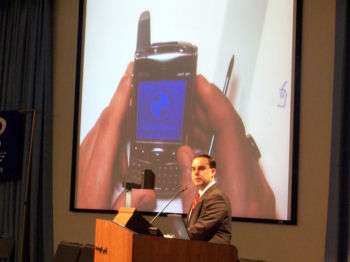|
 Jason J. Canty of Verizon Wireless, a ten-year veteran
in telecommunications, must have hit a chord with our meeting
attendees as our January meeting ran over an hour and a half.
There were plenty of questions from the floor as Jason explained
the evolution of wireless telephony. Three technologies are used
in the design of cell phones in the USA. Verizon and Sprint use
CDMA. IS-136 TDMA is used by AT&T, and GSM is used by Cingular.
Some older technology analog cell phone systems are still active
in the USA. Each technology is not compatible with the others.
The location of technology hardware on cell towers determines
the geographic areas of cell phone coverage and these differ
by company. Each technology has its benefits and shortcomings,
but the more robust solution is CDMA and its next generation
CDMA2000 or CDMA2k. The GSM technology is used in Europe, and
is not compatible with systems used in the USA. (See author’s
note at end of this article.) Jason J. Canty of Verizon Wireless, a ten-year veteran
in telecommunications, must have hit a chord with our meeting
attendees as our January meeting ran over an hour and a half.
There were plenty of questions from the floor as Jason explained
the evolution of wireless telephony. Three technologies are used
in the design of cell phones in the USA. Verizon and Sprint use
CDMA. IS-136 TDMA is used by AT&T, and GSM is used by Cingular.
Some older technology analog cell phone systems are still active
in the USA. Each technology is not compatible with the others.
The location of technology hardware on cell towers determines
the geographic areas of cell phone coverage and these differ
by company. Each technology has its benefits and shortcomings,
but the more robust solution is CDMA and its next generation
CDMA2000 or CDMA2k. The GSM technology is used in Europe, and
is not compatible with systems used in the USA. (See author’s
note at end of this article.)
Jason offered the following
when planning to purchase a new cell phone:
- Does it provide the geographical coverage you require? This can only be achieved by physically taking the candidate cell phone to the various environs you expect to use it in. Most companies will allow a fifteen-day trial test period for this purpose. Where this is not possible (i.e. you don’t plan to go to Florida during the trial period), you are stuck with the promotional description of cell phone coverage offered by the company where you plan to purchase the cell phone.
- Does it have the cell phone features you plan to use such as text messaging, picture messaging, etc.
- Price of Cell phone and service contract taking into consideration all issues affecting your costs over the contract period.
- You are likely to replace the phone for one reason or another within three years (authors estimate), at which time you will have the opportunity to plan the next cell phone purchase all over again.
Jason topped off his presentation
with some cell phones he had with him, along with web page displays
of cell phones, at www.verizonwireless.com. After the formal
presentation Jason stayed around to answer more questions on
a one-to-one basis.
Author’s note: For a much more lengthy description of the
evolution of the cell phone industry, including the technical,
development, competitive, financial, and marketing challenges,
see: http://bitpim.sourceforge.net/papers/phonespecs/
and click on “this article” by Stephen Den Beste.
The evolution of this market continues.
|


